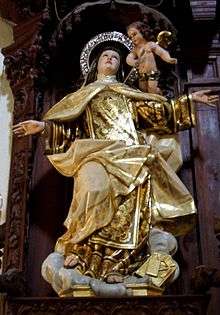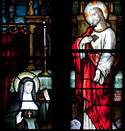Religious ecstasy

Religious ecstasy is a type of altered state of consciousness characterized by greatly reduced external awareness and expanded interior mental and spiritual awareness, frequently accompanied by visions and emotional (and sometimes physical) euphoria.
Although the experience is usually brief in time,[1] there are records of such experiences lasting several days or even more, and of recurring experiences of ecstasy during one's lifetime.
A person's sense of time and space disappear during a religious ecstasy forsaking any senses or physical cognizance in its duration. Among venerated Catholic saints who dabble in Christian mysticism, a person's physical stature, human sensory, or perception is completely detached to time and space during an ecstatic experience.
In Sufism, the term is referred to as wajd and the experience is referred to as either jazbah or majzoobiyat.
Context

The adjective "religious" means that the experience occurs in connection with religious activities or is interpreted in context of a religion. Marghanita Laski writes in her study "Ecstasy in Religious and Secular Experiences," first published in 1961:
"Epithets are very often applied to mystical experiences including ecstasies without, apparently, any clear idea about the distinctions that are being made. Thus we find experiences given such names as nature, religious, aesthetic, neo-platonic, sexual etc. experiences, where in some cases the name seems to derive from trigger, sometimes from the overbelief, sometimes from the known standing and beliefs of the mystic, and sometimes, though rarely, from the nature of the experience.
Ecstasies enjoyed by accepted religious mystics are usually called religious experiences no matter what the nature of the ecstasy or the trigger inducing it."[2]
Exclusive and inclusive views
.jpg)
Religious people may hold the view that true religious ecstasy occurs only in their religious context (e.g. as a gift from the supernatural being whom they follow) and it cannot be induced by natural means (human activities). Trance-like states which are often interpreted as religious ecstasy have been deliberately induced with techniques or ecstatic practices; including, prayer, religious rituals, meditation, breathing exercises, physical exercise, sex, music, dancing, sweating, fasting, thirsting, and psychotropic drugs. An ecstatic experience may take place in occasion of contact with something or somebody perceived as extremely beautiful or holy. It may also happen without any known reason. The particular technique that an individual uses to induce ecstasy is usually one that is associated with that individual's particular religious and cultural traditions. As a result, an ecstatic experience is usually interpreted within the particular individual religious context and cultural traditions. These interpretations often include statements about contact with supernatural or spiritual beings, about receiving new information as a revelation, also religion-related explanations of subsequent change of values, attitudes and behavior (e.g. in case of religious conversion).
Achieving ecstatic trances is a shamanic activity, inducing ecstasy for such purposes as traveling to heaven or the underworld, guiding or otherwise interacting with spirits, clairvoyance, and healing. Some shamans take drugs from such plants as Ayahuasca, peyote and cannabis (drug) or certain mushrooms in their attempts to reach ecstasy, while others rely on such non-chemical means as ritual, music, dance, ascetic practices, or visual designs as aids to mental discipline.
Examples
Athletes may follow rituals in preparing for contests, which are dismissed as superstition, but this sports psychology device may help them to attain advantage in an ecstasy-like state.
Yoga provides techniques to attain an ecstasy state called samādhi. According to practitioners, there are various stages of ecstasy, the highest being Nirvikalpa Samadhi. Bhakti Yoga especially, places emphasis on ecstasy as being one of the fruits of its practice.
In Buddhism, especially in the Pali Canon, there are eight states of trance also called absorption. The first four states are Rupa or, materially-oriented. The next four are Arupa or non-material. These eight states are preliminary trances which lead up to final saturation. In Visuddhimagga, great effort and years of sustained meditation are practiced to reach the first absorption, and that not all individuals are able to accomplish it at all.
Modern meditator experiences in the Thai Forest Tradition, as well as other Theravadin traditions, demonstrates that this effort and rarity is necessary only to become completely immersed in the absorptions and experience no other sensations. It is possible to experience the absorptions in a less intense state with much less practice.
In the Dionysian Mysteries, initiates used intoxicants and other trance-inducing techniques (like dance and music) to remove inhibitions and social constraints, liberating the individual to return to a natural state.
In the monotheistic tradition, ecstasy is usually associated with communion and oneness with God. However, such experiences can also be personal mystical experiences with no significance to anyone but the person experiencing them. Some charismatic Christians practice ecstatic states (such as "being slain in the Spirit") and interpret these as given by the Holy Spirit. The firewalkers of Greece dance themselves into a state of ecstasy at the annual Anastenaria, when they believe themselves under the influence of Saint Constantine.[3] [4][5]
Historically, large groups of individuals have experienced religious ecstasies during periods of Christian revivals, to the point of causing controversy as to the origin and nature of these experiences.[6][7] In response to claims that all emotional expressions of religious ecstasy were attacks on order and theological soundness from the Devil, Jonathan Edwards published his now-famous and influential Treatise on Religious Affections. Here, he argues, religious ecstasy could come from oneself, the Devil, or God, and it was only by observing the fruit, or changes in inner thought and behaviour, that one could determine if the religious ecstasy had come from God.[8]
In hagiography (writings about Christian saints) many instances are recorded in which saints are granted ecstasies. According to the Catholic Encyclopedia[9] religious ecstasy (called "supernatural ecstasy") includes two elements: one, interior and invisible, in which the mind rivets its attention on a religious subject, and another, corporeal and visible, in which the activity of the senses is suspended, reducing the effect of external sensations upon the subject and rendering him or her resistant to awakening. The witnesses of a Marian apparition often describe experiencing these elements of ecstasy.
Modern Witchcraft traditions may define themselves as "ecstatic traditions," and focus on reaching ecstatic states in their rituals. The Reclaiming Tradition and the Feri Tradition are two modern ecstatic Witchcraft examples.[10][11]
As described by the Indian spiritual teacher Meher Baba, God-intoxicated souls known as masts experience a unique type of spiritual ecstasy: "[M]asts are desperately in love with God – or consumed by their love for God. Masts do not suffer from what may be called a disease. They are in a state of mental disorder because their minds are overcome by such intense spiritual energies that are far too much for them, forcing them to lose contact with the world, shed normal human habits and customs, and civilized society and live in a state of spiritual splendor but physical squalor. They are overcome by an agonizing love for God and are drowned in their ecstasy. Only the divine love embodied in a Perfect Master can reach them."[12]
See also
- Altered state of consciousness
- Animal faith
- Ecstasy (philosophy)
- Ecstasy (emotion)
- Enlightenment (spiritual)
- Entheogen
- Eroto-comatose lucidity
- Higher consciousness
- Mast (Sufism)
- Mysticism
- Neurotheology
- Nirvana
- Numinous
- Religious experience
- Sex magic
- Shamanism
- Wajad
- Self-transcendence
Notable individuals or movements
- Anastenaria
- St. Thomas Aquinas experienced an ecstasy during a church service towards the end of his life that caused him to stop writing.
- Dionysus
- St. Teresa of Avila, Roman Catholic mystic, first entered states of ecstasy while studying religious texts when taken ill in a Carmelite cloister.
- Sri Caitanya Mahaprabhu, founder of Gaudiya Vaishnavism, immersed into deeper and deeper stages of ecstasy towards Krishna during the last 24 years of his life
- St. Pio of Pietrelcina
- St. Joseph of Cupertino
- Maulanah Rumi, Mystic Poet
- Hafez, Mystic Poet
- Moinuddin Chishti, Sufi Saint
- Amir Khusrow, Mystic Poet
References
- ↑ Marghanita Laski, "Ecstasy. A Study of Some Secular and Religious Experiences." The Cresset Press, London, 1961. p.57
- ↑ Marghanita Laski, "Ecstasy in Religious and Secular Experiences." Jeremy P. Tarcher, Inc., Los Angeles, 1990, ISBN 0-87477-574-4 p.171
- ↑ Xygalatas, Dimitris, "Firewalking and the Brain: The Physiology of High-Arousal Rituals", in: Joseph Bulbulia, Richard Sosis, Erica Harris, Russell Genet, Cheryl Genet, and Karen Wyman (eds.) Evolution of Religion: Studies, Theories, and Critiques, Santa Margarita, CA: Collins Foundation Press 2007, pp. 189–195
- ↑ Xygalatas, Dimitris, 2012. The Burning Saints. Cognition and Culture in the Fire-walking Rituals of the Anastenaria London: Equinox ISBN 978-1-84553-976-4
- ↑ Tomkinson, John L., Anastenaria, Anagnosis, Athens, 2003 ISBN 960-87186-7-8 pp 90–99
- ↑ Chauncy, Charles. Seasonable Thoughts on the State of Religion in New England. 1743
- ↑ Edwards, Jonathan (1742). Some Thoughts Concerning the Present Revival in New England and the Way it Ought to be Acknowledged and Promoted.
- ↑ Treatise on Religious Affections at Google Books
- ↑ Ecstasy
- ↑ M. Macha Nightmare, Reclaiming Tradition Witchcraft, Witchvox, 2001. Retrieved on 2008-01-13.
- ↑ Cholla and Gabriel, Ecstasy and Transgression in the Faery Tradition, Witch Eye, 2000. Retrieved on 2008-01-13.
- ↑ Kalchuri, Bhau: Meher Prabhu: Lord Meher, the Biography of the Avatar of the Age, Meher Baba, Volume Six, Manifestation, Inc., 1986, p. 2035
